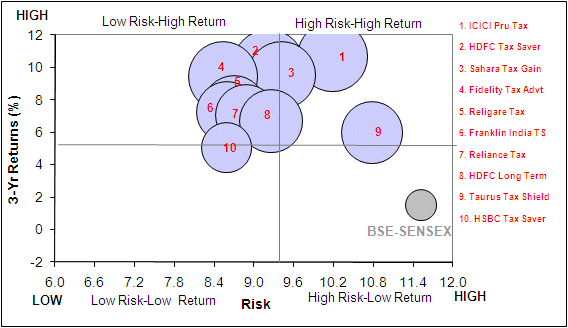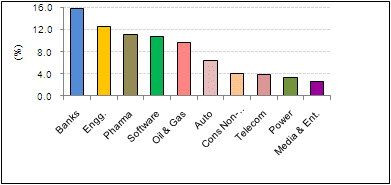Flavour of the season: ELSS |  |
The reason I am publishing this email posted to me is that I completely believe, agree and follow this philosophy in making my Investments. Disclosure: I am subscribed to Fidelity Tax saving Fund and Quantum Tax saving Fund (not mentioned here, since not completed 3 years I believe, but I really appreciate their approach as an Asset Management Company)
With the Direct Tax Code (DTC) proposing elimination of Equity Linked Mutual Funds (ELSS) (also known as Tax Saving Mutual Funds) from the list of tax-saving options; mutual fund houses are doing their best to increase their AUM (Assets Under Management) share under the ELSS category of mutual funds.
In order to make hay when the sun shines, they (mutual fund houses) are doling out generous commissions (in the range of 2.5% to 5.0%) from their own pocket, to their distributors thereby pushing ELSS funds before they lose out their “tax benefit” status with effect from April 1, 2012. So now, the next time you approach your distributor for investing to obtain a tax benefit (under Section 80C of the Income Tax Act, 1961), he would be all ready with the ELSS fund’s return chart (and off course his commission chart!) thereby persuading you to invest in them.
However in our opinion, while investing to avail a tax benefit (under Section 80C) it is vital that you consider the following aspects of financial planning too before signing a cheque, which would enable you in making prudent tax saving investment decisions.
- Age
Your age should determine your asset allocation. To simply put, how much percentage of your total investible amount should be in equity related instruments, fixed income instruments and gold. So, if you are young, you can take more risk and vice-versa. Hence, for prudent tax planning too, if you are young, you should allocate more towards market-linked tax saving instruments such as ELSS. Moreover, you would also enjoy the advantage of greater investment tenure which would enable you make more aggressive investments and create wealth over the long-term to meet your financial goals.
- Income
Similarly, if your income is high, your willingness to take risk is generally high. This thus can work in your favour, as you can skew your portfolio more towards equity related instruments such as ELSS, and make your portfolio appear more aggressive. Similarly, if your income is not high enough (i.e. it is low), you can invest in tax saving instruments which provide you assured returns. These instruments can be Public Provident Fund (PPF), National Savings Certificates (NSCs), 5 Yr Bank Fixed Deposits, 5 Yr Post Office Time Deposits, Senior Citizen Savings Scheme (provided you are a senior citizen) and Non-ULIP insurance plans.
- Financial goals
If you have financial goals set in your life, that too should influence the way you do your tax planning and invest in tax saving instruments. So, say for example your goal is retiring from work 5 years from now, then your tax saving investment portfolio will be also less skewed towards market-linked tax saving instruments, as you are quite near to your goal and your regular income will stop. Likewise if you are many years away from the financial goal, you should ideally allocate maximum to market linked tax saving instruments and less towards those instruments (tax saving) which provide you assured returns.
- Risk Appetite
It refers to your ability to take risk while investing, and it is function of your age, income, expenses, and nearness to goal. So, if your willingness to take risk is high (aggressive), you can skew your tax saving investment portfolio more towards the market-linked instruments such as ELSS.
Similarly, if your willingness to take risk is relatively low (conservative), your tax saving investment portfolio can be skewed towards instruments (such as PPF, NSC, 5-Yr bank FDs, 5-Yr Post Office Time Deposits, Senior Citizen Savings Scheme etc. which offer you assured returns. Also if you are a moderate risk taker you can take a mix of 60:40 into market-linked tax saving instruments and assured return tax saving instruments respectively.
And now if your age permits (i.e. if you are young), income is high, and therefore willingness to take risk is high along with your financial goals being far away, then you may look at ELSS funds to avail a tax benefit under section 80C. Please note that ELSS funds are 100% diversified equity funds and a distinguishing feature about them is the compulsory lock-in period of 3 years (which in our opinion helps in infusing a sense of discipline towards holding one’s investments for the long-term). Also they demand a petite minimum investment amount of 500, which is unlike the other equity oriented funds (who generally demand
500, which is unlike the other equity oriented funds (who generally demand  5,000 as the minimum investment amount).
5,000 as the minimum investment amount).
How ELSS Funds have fared across time frames
| Scheme Name | 6 Months (%) | 1-Yr (%) | 3-Yr (%) | 5-Yr (%) | Std. Dev (%) | Sharpe Ratio | Top 10 stocks (%) | Expense Ratio | Portfolio T/O Ratio (%) |
|---|---|---|---|---|---|---|---|---|---|
| ICICI Pru Tax Plan (G) | -3.4 | 11.1 | 10.7 | 11.0 | 10.18 | 0.06 | 37.2 | 2.0 | 121.0 |
| HDFC TaxSaver (G) | -4.8 | 14.6 | 10.1 | 13.2 | 9.22 | 0.07 | 38.8 | 1.9 | 30.6 |
| Sahara Tax Gain (G) | -6.7 | 13.4 | 9.5 | 14.0 | 9.41 | 0.05 | 25.5 | 2.5 | 205.8 |
| Fidelity Tax Advt (G) | -4.6 | 17.1 | 9.4 | - | 8.53 | 0.06 | 39.6 | 2.0 | 20.0 |
| Religare Tax Plan (G) | -7.6 | 10.0 | 7.6 | - | 8.70 | 0.04 | 37.2 | 2.5 | 76.0 |
| Franklin India Taxshield (G) | -1.4 | 12.8 | 7.2 | 12.1 | 8.59 | 0.03 | 46.9 | 2.1 | 85.8 |
| Reliance Tax Saver (G) | -10.3 | 9.2 | 7.0 | 9.8 | 8.88 | 0.03 | 35.9 | 1.9 | 86.0 |
| HDFC Long Term Adv (G) | -3.7 | 14.7 | 6.7 | 10.0 | 9.25 | 0.04 | 46.7 | 2.1 | 15.7 |
| Taurus Tax Shield (G) | -7.7 | 10.8 | 6.0 | 12.7 | 10.78 | 0.04 | 42.9 | 2.5 | 159.0 |
| HSBC Tax Saver Equity (G) | -7.7 | 4.9 | 5.1 | - | 8.59 | 0.00 | 42.2 | 2.3 | 119.0 |
| BSE Sensex | -2.4 | 9.8 | 1.5 | 11.8 | 11.52 | -0.03 | - | - | - |
(Source: ACE MF, PersonalFN Research)
Ideally while evaluating ELSS funds, one should assess their performance over a 3-Yr time frame, since this would enable you to judge whether they have created wealth for you post the lock-in period. The table above reveals that over the 3-Yr time frame most ELSS funds have delivered competitive returns with ICICI Pru Tax being the frontrunner (by delivering a return of 10.7% CAGR). However, when observed from a risk exposure perspective, ICICI Pru Tax Plan has exposed its investors to comparatively high risk (Standard Deviation of 10.18%) and has thus delivered middling risk-adjusted returns (as revealed by its Sharpe Ratio of 0.06), thus making it a high risk-high return investment proposition amongst the peers (see risk-return comparison chart below). Also, the returns have been drawn by the fund manager of ICICI Pru Tax Plan, by engaging in frequent churning (Portfolio Turnover Ratio of 121.0%) which has led to a high expense ratio for the fund.
On the other hand HDFC TaxSaver Fund, Fidelity Tax Advantage Fund too has delivered luring returns over a 3-Yr time frame (10.1% CAGR and 9.4% CAGR respectively), but the same have been drawn by exposing their investors to comparatively low risk (Standard Deviation of 9.22% and 8.53% respectively) and providing enticing risk-adjusted returns too (Sharpe Ratio of 0.07 and 0.06 respectively), thereby making them low risk-high return investment proposition in the category. Moreover, the returns have been delivered by the respective fund managers without indulging in much churning (Portfolio Turnover Ratio of 30.6% and 20.0% respectively) which has led to lower expenses ratios too of 1.9 and 2.0 respectively.
Risk-Return Comparison

Please note we are giving importance to portfolio churning as well expense ratio, as any elevated levels of these tend to increase cost for you investors. Moreover, in our opinion churning is just not necessary as the fund manager has the advantage of “buy and hold” strategy on account of the 3 year lock-in period imposed on its investors. Moreover, this also leaves the fund manager(s) with less burden of managing redemption pressures.
Hence, please recognise that there’s more to selecting a mutual fund (be it any kind!) than just the returns, and hence you need to allot significant weightage to the same while considering funds for your portfolio.
Sector Holdings
|  |
(Source: ACE MF, PersonalFN Research)
As far as the portfolio strategy is concerned ELSS funds have a fairly diversified equity portfolio but conquered by various sectors which are resilient and having a long-term growth prospects. Moreover, most ELSS generally follow a blend style of investing which enable them to do undertake both – growth as well as value investing.
In a nutshell...
Primarily while investing in tax-saving instruments, please make an attempt to complement your financial planning exercise with your tax-saving (by considering the aforementioned aspects of age, income, risk appetite and financial goals) as this would enable in making a prudent investment decision. Moreover, please do not wait till the eleventh hour as this may lead you to making a wrong choice.
While considering an ELSS fund for your market-linked tax-saving portfolio, give importance to those ELSS funds that have completed at least 3 years of track record and select funds from fund houses which follow strong investment systems and processes. Don’t get just lured by the returns chart which you mutual distributor exhibits to you, as remember there’s more to a mutual scheme than just returns. Look for the consistency in the performance instead, with relevance to risk and returns, portfolio turnover ratio expense ratio and the portfolio of the ELSS fund(s).